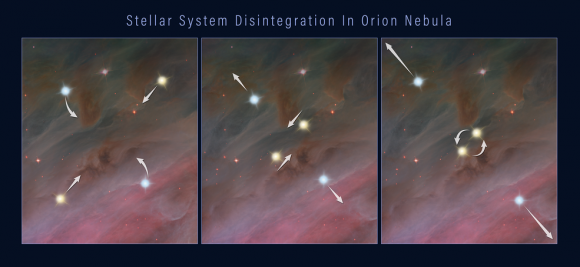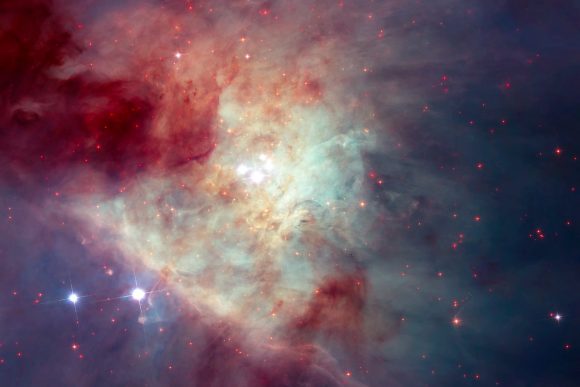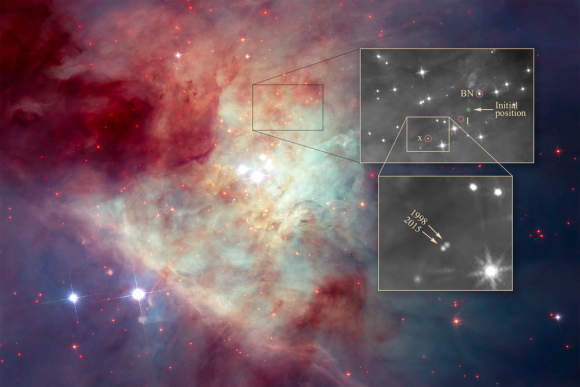It sometimes doesn't take much to tear a family apart. A Christmas dinner gone wrong can do that. But for a family of stars to be torn apart, something really huge has to happen.
The dramatic break-up of a family of stars played itself out in the Orion Nebula, about 600 years ago. The Orion Nebula is one of the most studied objects in our galaxy. It's an active star forming region, where much of the star birth is concealed behind clouds of dust. Advances in infrared and radio astronomy have allowed us to peer into the Nebula, and to watch a stellar drama unfolding.

This three-frame illustration shows how a grouping of stars can break apart, flinging the members into space. Panel 1: members of a multiple-star system orbiting each other. Panel 2: two of the stars move closer together in their orbits. Panel 3: the closely orbiting stars eventually either merge or form a tight binary. This event releases enough gravitational energy to propel all of the stars in the system outward, as shown in the third panel.
Credits: NASA, ESA, and Z. Levy (STScI)
Over the last few decades, observations showed the two of the stars in our young family travelling off in different directions. In fact, they were travelling in opposite directions, and moving at very high speeds. Much higher than stars normally travel at. What caused it?
Astronomers were able to piece the story together by re-tracing the positions of both stars back 540 years. All those centuries ago, around the same time that it was dawning on humanity that Earth revolved around the Sun instead of the other way around, both of the speeding stars were in the same location. This suggested that the two were part of a star system that had broken up for some reason. But their combined energy didn't add up.
Now, the Hubble has provided another clue to the whole story, by spotting a third runaway star. They traced the third star's path back 540 years and found that it originated in the same location as the others. That location? An area near the center of the Orion Nebula called the Kleinmann-Low Nebula.

This composite image of the Kleinmann-Low Nebula, part of the Orion Nebula complex, is composed of several pointings of the NASA/ESA Hubble Space Telescope in optical and near-infrared light. Infrared light allows to peer through the dust of the nebula and to see the stars therein. The revealed stars are shown with a bright red colour in the image. With this image, showing the central region of the Orion Nebula, scientists were looking for rogue planets and brown dwarfs. As side-effect they found a fast-moving runaway star. By ESA/Hubble, CC BY 4.0, https://commons.wikimedia.org/w/index.php?curid=57169218
The team behind these new results, led by Kevin Luhman of Penn State University, will release their findings in the March 20, 2017 issue of The Astrophysical Journal Letters.
"The new Hubble observations provide very strong evidence that the three stars were ejected from a multiple-star system," said Luhman. "Astronomers had previously found a few other examples of fast-moving stars that trace back to multiple-star systems, and therefore were likely ejected. But these three stars are the youngest examples of such ejected stars. They're probably only a few hundred thousand years old. In fact, based on infrared images, the stars are still young enough to have disks of material leftover from their formation."

Young stars have a disk of gas and dust around them called a protoplanetary disk. Credit: NASA/JPL-Caltech
"The Orion Nebula could be surrounded by additional fledging stars that were ejected from it in the past and are now streaming away into space." - Lead Researcher Kevin Luhman, Penn State University.
The three stars are travelling about 30 times faster than most of the Nebula's other stellar inhabitants. Theory has predicted the phenomenon of these breakups in regions where newborn stars are crowded together. These gravitational back-and-forths are inevitable. "But we haven't observed many examples, especially in very young clusters," Luhman said. "The Orion Nebula could be surrounded by additional fledging stars that were ejected from it in the past and are now streaming away into space."
The key to this mystery is the recently discovered third star. But this star, the so-called "source x", was discovered by accident. Luhman is part of a team using the Hubble to hunt for free-floating planets in the Orion Nebula. A comparison of Hubble infrared images from 2015 with images from 1998 showed that source x had changed its position. This indicated that the star was moving at a speed of about 130,000 miles per hour.

The image by NASA's Hubble Space Telescope shows a grouping of young stars, called the Trapezium Cluster (center). The box just above the Trapezium Cluster outlines the location of the three stars. A close-up of the stars is top right. The birthplace of the multi-star system is marked "initial position." Two of the stars — labeled BN, and "I," for source I — were discovered decades ago. Source I is embedded in thick dust and cannot be seen. The third star, "x," for source x, was recently discovered to have moved noticeably between 1998 and 2015, as shown in the inset image at bottom right.
Credits: NASA, ESA, K. Luhman (Penn State University), and M. Robberto (STScI)
Luhmann then re-traced source x's path and it led to the same position as the other 3 runaway stars 540 years ago: the Kleinmann-Low Nebula.
According to Luhmann, the three stars were most likely ejected from their system due to gravitational fluctuations that should be common in a high-population area of newly-born stars. Two of the stars can come very close together, either forming a tight binary system or even merging. That throws the gravitational parameters of the system out of whack, and other stars can be ejected. The ejection of those stars can also cause fingers of matter to flow out of the system.
As we get more powerful telescopes operating in the infrared, we should be able to clarify exactly what happens in areas of intense star formation like the Orion Nebula and its embedded Kleinmann-Low Nebula. The James Webb Space Telescope should advance our understanding greatly. If that's the case, then not only will the details of star birth and formation become much clearer, but so will the break up of young families of stars.
No comments:
Post a Comment